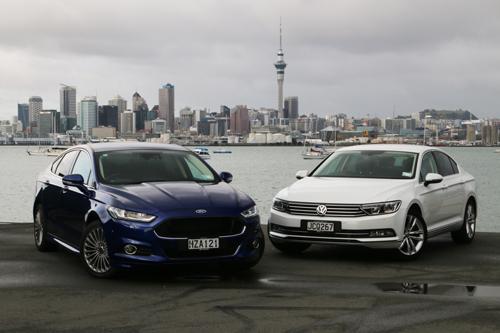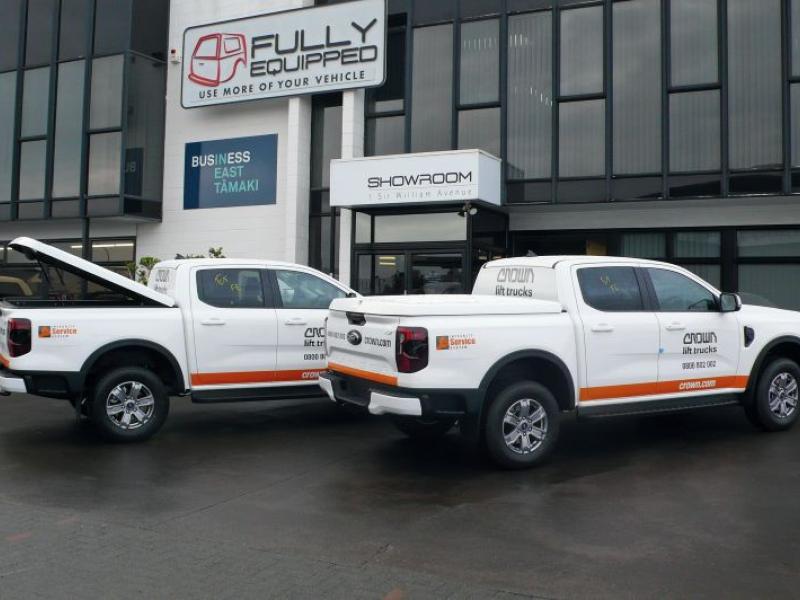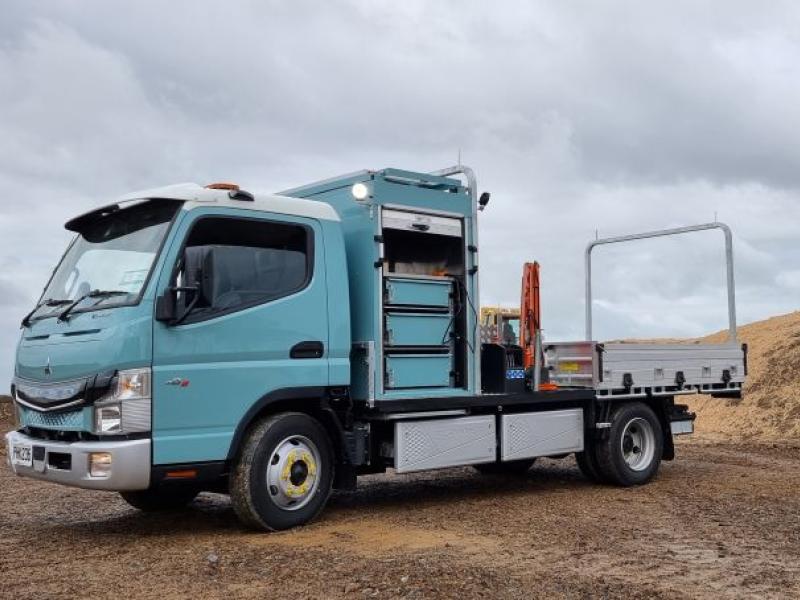Choosing modern cars is getting more and more difficult, with specification differences sometimes leaving you scratching your head in frustration. So we set out to take away the hype and give you the facts about the two latest European mid-size cars, in a direct one-on-one comparison test. Report John Oxley, photography Damien O’Carroll.
The two most recently introduced medium sized cars to hit New Zealand are the Ford Mondeo and the Volkswagen Passat. Both are built on completely new platforms, and both are packed full of features, with the Mondeo in particular hosting safety technology which has never been seen before in the shape of inflatable “airbag” rear seatbelts, the first devices to protect rear seat passengers in a front-end crash.
We covered the Mondeo in detail in our cover story in our June issue, while the Passat launch is included in this issue’s New Models feature (see pxx).
However, for this test we managed to get both vehicles at the same time and place, with Damien O’Carroll and I giving them a good workout which quickly highlighted their strengths and weaknesses.
Our test circuit of about 250km including town, motorway, urban and rural roads, and just about all the different road surfaces you get in the Auckland region, from smooth tarmac to coarse chip, so we could compare ride and noise levels. There were also quite a few tight twisting sections where we could do an eggs-for-eggs comparison of their handling ability. And, of course, we each drove both cars.
THE CARS
The Mondeo is a bit late coming to the party – it was originally launched in the US as the Ford Fusion back in 2012 – but the reason for its delay is a sound one: Ford moved production from Belgium to Spain, and also wanted to add in some new technology.
There are several versions in the current range, including 149kW petrol models and a 132kW diesel, but for the test we wanted the top-spec cars. Ford doesn’t sell a Mondeo sedan any more, but offers both wagon and hatch models; we chose the Titanium hatch, which has a 177kW 2-litre turbo-charged EcoBoost engine
The Passat, on the other hand, is sparkling new, having been launched in Europe earlier this year, where it promptly won the European Car of the Year Award. It’s the eighth generation of Passat, and there are currently 132kW turbo-charged 1.8-litre petrol engines and a 172kW twin-turbo diesel with all-wheel drive, but rumbustious 206kW petrol and a 140kW turbo-diesel are on the way.
We wanted the two to match tas much as we could, so chose the Passat R-Line sedan, although, as with the Mondeo, there are wagons on offer too.
On the face of it they are a good price match, and on base price there’s $1,600 between them, at $53,390 and $54,990 respectively, with the Volkswagen the more expensive; however, this difference changes dramatically when you “option up” the Passat to match the Mondeo’s safety and feature specifications.
We have provided a checklist of which car has what so you can directly compare them; however, we’ll run through some of the features as we go along. We’ve also provided a chart with some technical keynotes.
We scored the cars in the following categories:
- Overall fitness for purpose.
- Exterior styling and design.
- Interior design and comfort.
- Fit, finish and quality.
- Ride and refinement.
- Powertrain performance.
- Road holding and handling.
- Safety rating.
- Fuel economy.
- Value for money.
Here are some of the comments we made along the way.
THE MONDEO
The latest Mondeo is a brutish-looking machine on the road – and especially when it’s filling your rearview mirrors – and it may well be “the look” Ford needs to convince Falcon buyers to move to four-cylinder engines and front-wheel drive.
The face of the latest car is very Aston Martin, and looks even more masculine than even the Falcon XR8, while from the side the look is definitely sporty, with a body kit that enhances the styling even further, while the fastback lines readily disguise that it’s actually a five-door hatchback, the only giveaway being the big wiper on the rear window.
The back of the vehicle, though, is a bit of a disappointment, and it’s hard to understand why the Ford designers didn’t move further away from the appearance of the outgoing model when they did the rear end!
The car sits firmly on the road, with 18 inch alloy wheels as standard.
However, there were no disappointments inside the car, and both of us liked the seats, which get 10-way electric adjustment, and there are three memory settings so the car can be shuffled around between drivers without them having to re-adjust the seats every time. Their strong side bolsters and height good adjustment gave an excellent seating position. It was a cold day, and we loved the seat heaters!
The layout of the car’s controls is good, and logical, but sometimes it was quite tedious having to get into the computer’s main menu to change settings. That said, the Sync II voice control does allow you to change a lot of stuff by just telling the car what to do, including satnav instructions, music choices and dialling numbers.
The interior design is plain and simple black with some polished metal highlights, and we both felt the car was very spacious and comfortable. The leather trim was of high quality and the steering wheel leather-rimmed, with satellite controls for, well just about everything, including easy access to all the settings you’re likely to want to change. And, of course, answering the phone…
The centre touchscreen features a big eight-inch display, and it’s easy to find your way around.
As far as space is concerned, there’s lots of room back and front, easily enough to carry five big blokes. And boot space is superb, with a split-fold seat enlarging it even further. The best thing, though, is the easy loading, with a “lift up” of 620mm, and a low lip, plus a big 920mm access. The boot is 1,350mm wide narrowing to 1,140mm, and its 1,070mm deep, expanding to 1,802mm with the seats folded (giving a flat floor).
On the road the car gave lots of feedback through the chassis, but it was never harsh or intrusive. There was some body roll even in the Sport setting, but the handling was quite brilliant, well-controlled and very stable – although torque steer was evident at times.
The gold star, however, must go to the engine. Ford has built-in a special sound effects package to make the engine sound good, and when you’re hitting the loud pedal it sounds quite aggressive, with turbo whine sometimes evident. Lovely stuff.
The six-speed torque converter auto transmission, too, is brilliant, with the added benefit of steering wheel paddles to give good manuall control, responsive and smooth.
Damien’s big thing is music, and when he says a sound system is good, it usually is. However, he described the Mondeo’s as “awesomely good sound”.
Summing up: “A brilliant blend of superb comfort and impressive handling. But is does feel like quite a big car, though!”
THE PASSAT
The latest Passat is the most refined yet, not just in terms of its dynamics and its finishes, but also in the way it looks. Where the Mondeo looks tough and energetic, the Passat looks refined and gentile.
The new grille design makes the car seem lower and wider, while the strong crease line evident right along the car gives it length and strength.
As with the Mondeo the Passat gets a body kit (in R-Line specification), and it gets 19 inch alloy wheels compared to the Mondeo’s 18 inch ones.
Again, we both loved the seats, which feature strong side bolstering, and were impressed by the beautiful Nappa leather and Alcantara trim.
There’s lots of polished aluminium trim around the cabin, and we liked the flat bottomed steering wheel, which also has satellite controls. The whole feel of the interior is of quiet quality, and the finishes were up to the high standard we’ve come to expect from, Volkswagen.
It was surprising, then, that although the car has a pushbutton starter, the key fob must be used to lock and unlock the car; a proximity key is an extra-cost option ($1,500). Included in this “keyless access” pack is electric opening and closing of the boot.
It was surprising, too, that the only electric adjustment on the seat (and only on the driver’s) was to the backrest tilt and the lumbar support. However, 14-way electric seats are available as a $3,000 option, and include a massage function.
The Passat gets a smaller 6.5 inch touchscreen than the Mondeo, but its functions are clear and logical. An eight-inch screen with voice control is only available on the top-line Bi-TDI R-line.
An analogue clock in the centre of the dash is a nice touch, and adds to the gentile look and feel.
Like the Mondeo, the Passat offers plenty of room back and front, and it also has a big boot. However, the rub comes when you try to put a big suitcase into the car, and find you have to lift it up and over a big lip. The boot is fairly square shaped, and 1,060mm wide and 1,105mm deep, enlarging to 1,904mm with the seats folded. A plus on the Passat is the “ski hatch” in the rear seat; a minus is the boot access of only 450mm. On the upside, the seat back release is in the boot, so the boot can only be accessed by opening the boot lid, a good security feature.
On the road the car feels very light and agile, and impressively quiet except at lower speeds where it sounded a bit like a diesel!. We did, however, encounter an odd slightly harsh edge to the ride, and lots of road surface feedback through the steering, which we put down to the 19 inch tyres.
Handling is excellent, and the Passat corners much flatter than the Mondeo; however, we did find it struggles for grip under exit in hard cornering.
Given its lower capacity than the Mondeo, it was not unexpected that low-down torque was not as forthcoming, with slow pickup from lower speeds; however it became very perky once aroused!
The Passat has a seven-speed double clutch gearbox as opposed to the Mondeo’s “normal” torque converter auto, and this undoubtedly was the reason why it was able to match the Mondeo’s 0-100km acceleration time and beat its fuel consumption figure. Well, that and the fact that it’s 72kg lighter, and has a stop-start system.
Summing up: “Feels surprisingly light and agile compared to the Mondeo. Order it on smaller wheels and it would be way better. But it’s seriously lacking in standard kit when compared to the Mondeo.”
Pluses
Ford
- All that safety kit
- Adaptive ride
- Adaptive cruise
- Bigger boot
- Great engine sound
- LED headlights
Volkswagen
- Fully secure boot
- Better fuel economy
Minuses
Ford
- Hatch not as secure as boot
- Some torque steer
Volkswagen
- Extra $11,000 to match Ford’s kit
- Scrabbles for grip at times
TESTER’S DECISION
We felt both cars are definitely at the top of their game, and both offer ideal “fit for purpose”. However, at the same time they differ slightly in that the Ford is more likely to appeal to someone who is “out there”, and wants to show it, while the Passat will probably be bought by customers who like to keep a lower profile.
In terms of fleetability, the Ford scores because it carries more and is easier to load, although if you’re carrying high price goods you might prefer the Passat’s more-secure boot.
The big clincher for the Ford, though, is in value-for-money. The Mondeo starts the bidding at $1,600 less than the Passat; however, by the time you’ve added a whacking $11,000 to (more or less) match its safety and comfort features, the difference is $12,600!
On top of that, when it comes to Health & Safety (and don’t forget, there’s likely to be more and more accent on company vehicle drivers in this regard as time goes on) the Ford scores hands down.
A definite winner!






